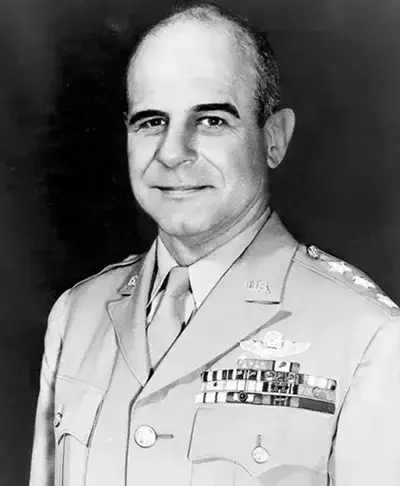- Military History
- Biographies
- Militarians Biographies
- General James Harold Doolittle
General James Harold Doolittle
American Army Air Corps general, best known for his daring and unconventional raid on Tokyo early In World War II (“Doolittle Raid”)
A native of Alameda, California, Doolittle was educated at Los Angeles Junior College and at the University of California. He joined the Army Reserve Corps in October 1917, after the United States entered World War I and was assigned to the Signal Corps in which he served as a flight instructor through 1919. The following year, Doolittle was commissioned a first lieutenant in the Army Air Service and gained national attention by making the first transcontinental flight in less than fourteen hours on the 4th of September in 1922.
Under sponsorship of the Army Air Corps, Doolittle enrolled in the aeronautical science program at Massachusetts Institute of Technology from which he earned a Sc.D. degree in 1925. Following this, he worked in several military aviation testing stations and became involved in air racing and in demonstrating aircraft during 1925, with the object of promoting aviation and military aviation in particular. In September 1929, he successfully showed the potential of instrument flying by making the first-ever blind instrument landing.
Doolittle resigned his commission in February 1930 to become aviation manager for Shell Oil, where he worked on the development of new high-efficiency aviation fuels. He also continued to race, claiming victories in several prestigious competitions, including those for the Harmon (1930) and Bendix (1931) trophies. In 1932, he set a world speed record.
With war clouds gathering in July 1940, Doolittle returned to active duty as a major in the Army Air Corps. In the months following the Japanese attack on Pearl Harbor (7th December 1941), the American and Allied forces were in a desperate defensive position in the Pacific theater. To raise U.S. morale and to force the Japanese to divert a portion of their air forces to defense, Doolittle planned and executed an extraordinary and extraordinarily hazardous bombing raid on the Japanese capital city of Tokyo (Known as the “Doolittle Raid” or “Tokyo Raid”).
He led sixteen B-25 bombers from the aircraft carrier Hornet on April 18, 1942. The aircraft were not designed to take off from an aircraft carrier and, doing so, demanded great skill. Fuel limitations meant that no return trip was possible. Doolittle and his men would have to land in China, hope to evade capture, and find their way back to Allied lines. The mission was as close to a suicide run as any ever undertaken by American fighting men. Its success was slight in strictly military terms and damage to Tokyo was not extensive. The raid on the Japanese homeland was a morale boost of incalculable proportions and did much to spur the American war effort. As planned, it also tied down a portion of the Japanese air force to home defense.
Doolittle and most of his raiders survived the action, and Doolittle was promoted to brigadier general. He was sent to England to organize the Twelfth U.S. Air Force in September 1942, and with the temporary rank of major general commanded the Twelfth in Operation Torch (the Allied invasion of French North Africa). During March 1943 to January 1944, he commanded strategic air operations in the Mediterranean theater and was promoted to the temporary rank of lieutenant general in March 1944. He was given command of the British-based Eighth Air Force's bombing operations against Germany from January 1944 to May 1945.
After the war ended in Europe, Doolittle returned to the Pacific where with the Eighth Air Force he provided support in the Battle of Okinawa (from April to July 1945) and the massive bombardment of the Japanese home islands.
Following the war in May 1946, Doolittle left active duty (remaining in the reserves) and took a senior executive position with Shell Oil. He was frequently tapped by the government to serve as an adviser on scientific, technological and aeronautical commissions during 1948-57. Following his retirement from Shell and the Air Force Reserve in 1959, he continued to work as a consultant not only in matters of science and aeronautics, but in national security policy issues as well. Doolittle was not only a gallant commander and an able military air tactician, he was an aviation pioneer who did much to promote the status of the U.S. military's air arm.
"Jimmy" Doolittle died at 96 in Pebble Beach, California on September 27, 1993 and is buried at Arlington National Cemetery in Virginia, near Washington, D.C. next to his wife. In his honor at the funeral there was also a flyover of Miss Mitchell, a lone B-25 Mitchell and USAF Eighth Air Force bombers from Barksdale Air Force Base, Louisiana.
General James Harold Doolittle - Quick Facts
- 12th Air Force (United States)
- 15th Air Force (United States)
- 8th Air Force (United States)
- United States Air Force
- United States Army Air Corps
- United States Army Air Forces
- United States Army Air Service
- WWI (1914-1918)
- WWII (1939-1945)
- Pacific War (1941-1945)
- Cold War (1947-1991)
- Korean War (1950-1953)
- {{#owner}}
- {{#url}} {{#avatarSrc}}
{{name}} {{/url}} {{^url}} {{#avatar}} {{& avatar}} {{/avatar}} {{name}} {{/url}} - {{/owner}} {{#created}}
- {{created}} {{/created}}
























